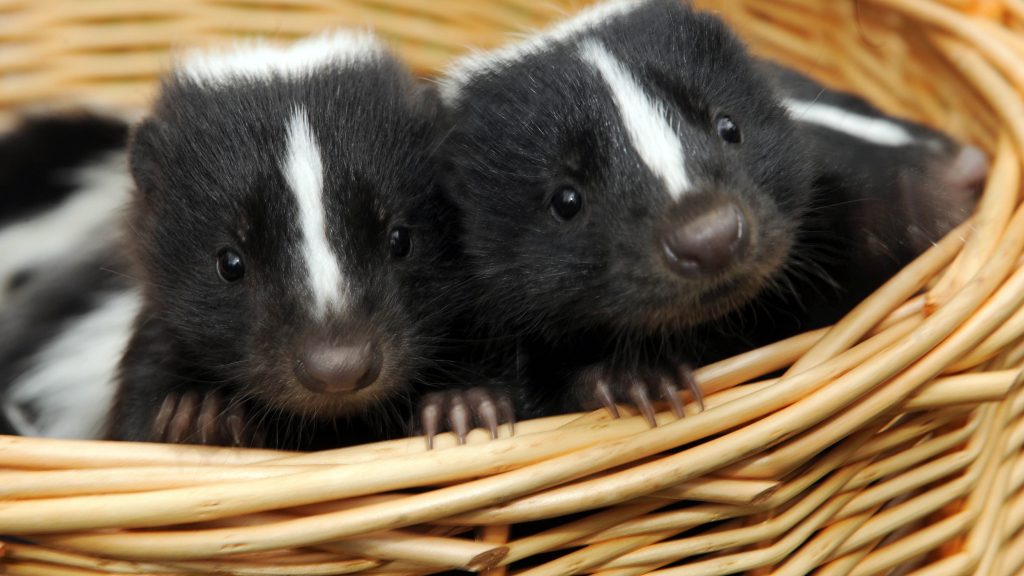Most people in the world have never seen a skunk. In fact, residents of North and South America, Indonesia, and the Philippines are the only people with a chance of seeing one in the wild, because these are the only places skunks call home. While skunks are common in many areas of Canada, the U.S., and Mexico, most people don’t realize that there are actually five separate species of skunks around the world.
- Striped Skunks (Mephitis mephitis)
Striped skunks are the most familiar species. They are the size of house cats with a white stripe down the middle of a long black tail. The pattern can vary, with some individuals being almost completely black and others mostly white. Striped skunks coexist with humans in suburban areas and can be spotted ambling along roadsides at night. When threatened, they stomp their paws, make their bodies into a u-shape, and can spray an oily substance from two anal glands.
- Spotted Skunks (Spilogale species)
Spotted skunks, true to their names, have three white spots on their faces and four on their backsides, as well as six stripes on the tail. These squirrel-sized skunks regularly climb trees and are best known for their endearing trick of balancing on front paws to do a handstand when frightened. The eastern spotted skunk (Spilogale putorius) lives in the eastern U.S. and rarely in southern Canada and northern Mexico. It prefers forests with a dense understory and is therefore observed infrequently. The southern Spilogale angustifrons and western Spilogale gracilis spotted skunks live farther to the south and west. The pygmy spotted skunk (Spilogale pygmaea) of Mexico’s west coast is about the size of a rat, and is by far the smallest and rarest skunk species.
- Hooded Skunks (Mephitis macroura)
Similar in size to the striped skunk, hooded skunks differ in hairdo, giving a first impression of an ungroomed Pekingese dog. Their black faces are framed by a shaggy white mane that covers the tops of their heads, bodies, and silky tails. Some individuals exhibit the reverse color pattern or are entirely black, but all have the same long hood for which they are named. They inhabit rocky areas of southwestern North and Central America, constructing burrows near streams where they can be seen pouncing on insects.
- Hog-Nosed Skunks (Conepatus species)
Although the naked pink snout of a hog-nosed skunk resembles that of a pig, their furry bodies look definitively skunk-like, with two white stripes extending down their black backs. Their snouts help them root for food in a variety of habitats. When startled, they do a side-stepping movement before turning their back ends around to spray. The North American hog-nosed skunk (Conepatus leuconotus) can be found in the southwestern U.S., and the other three species—striped (Conepatus semistriatus), Molina’s (Conepatus chinga), and Humboldt’s (Conepatus humboldtii) hog-nosed skunks—are common in Central and South America.
- Stink Badgers (Mydaus species)
Stink badgers have only recently been welcomed into the skunk family. Before 1990, the Sunda stink badger (Mydaus javanensis) of Indonesia and Palawan stink badger (Mydaus marchei) of the Philippines were considered close relatives of actual badgers, but recent DNA evidence has identified their true skunk family roots. They share many characteristics with other skunks but differ in being diurnal and in using their anal glands to mark vegetation. Much is yet to be discovered regarding their habits.
All skunks are gentle creatures that benefit nature and society by controlling insect populations. However, you do not want any type of skunk digging under your porch and raising a family there. Call Skedaddle Humane Wildlife Control at 1-888-592-0387 to help identify skunks on your property or to safely remove any that have gotten too close for comfort.



